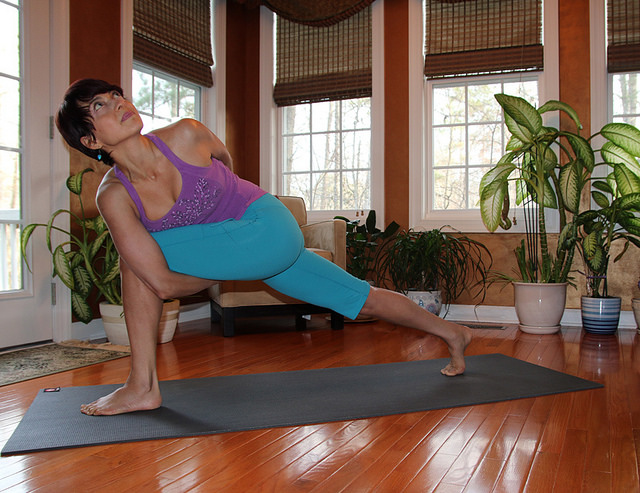At 27 years old, I’ve been practicing yoga for a little more than a third of my life.
For the majority of that time, I’ve relied heavily on my teachers for my asana practice. I’d go to the studio or shala almost every single day. But within the past two years or so, I’ve found that my home practice has become the place where I do my most important work and I spend more time practicing alone than ever before.
When I’m alone, I can exploring different strategies over and over until things make sense. I can sit in meditation as long as I want. I can laugh or cry as loudly as I need to. I can make my daily practices as long or as short as necessary.
I don’t imagine that I will ever stop needing (and wanting) my teachers to help me see things that I don’t notice on my own, as well as to point out the things that I purposely avoid. But after all this time under their loving, patient guidance, I finally trust my own inner wisdom enough to practice purposefully and impactfully without them.
Students ask me about home practice regularly. Often, people just want to know where they can get a free yoga podcast. While I think these videos can be useful and inspiring in their own way, they can’t replace a “real” teacher, nor do they give the practitioner the same benefits as practicing alone in silence, trusting the inner Self. When we practice alone, we get the chance to admire our own unique strength and resilience rather than trying mimic someone else’s.
I care about my students, so I miss them when they aren’t in class or when they move away. but what I really wish is for them not to need me forever. I want my students’ yoga practice to be self-sufficient, so my students never have to rely on being in the physical presence of a teacher or become too attached to a particular studio. When they are too broke to pay for classes, I want them to keep practicing. If they only have 20 minutes of free time, I want them to know how to use that time for practice. If they are feeling socially anxious and can’t be around other people, I still want them to have a practice. I want students to always make room for new perspectives and ideas from others, while also feeling empowered and knowing that they are their own greatest teacher.
Here is some advice for initiating a home practice:
Get up early
Our practice really starts the day before, when we are making decisions about when to get work done and when to go to bed. If we want to get up at 4:30 or 5 am, we need to plan the day before accordingly. Why so early? Well, I understand that this won’t work for everyone. But the benefits of an early practice include a quieter mind, a gentler attitude in general, an empty belly (because we haven’t had breakfast yet) and chances are, a quieter apartment or house.
I know how crazy things can get. When I did my 200-hour teacher training in 2009, I had about 15 roommates because I was a college kid living in a co-op. I know how that can easily become an excuse for not practicing. For me at that time, I would always go to a studio because I was not ready to trust myself enough to practice alone. But I’m pretty sure nobody would have bothered me too much at 4:30 am.
Practice mindful eating
If we want to make sure our practice happens, we have to give our body fuel and make sure to plan meals according to our practice schedule. For example, it’s not fun to wake up for an early practice after eating a burrito and passing out on the couch around 11 pm. Remember, morning practice begins the day before. I like to keep healthy snacks in my purse I so that I never have a reason to forget to eat. Eating these smaller snacks throughout the day allows me to eat lighter meals at mealtimes without being hungry. I’ve found this to be helpful for asanas, particularly on days when I can’t do a long practice until the evening.
Schedule practices at the beginning of the week
For some people, the super early practice is not going to work and that’s fine. But take some time at the beginning of every week to schedule practices. Put them in a Google calendar or another life organizer. If you are a householder or have a lot of roommates, it’s not a bad idea to put your practice schedule on the fridge. Not only does this help with accountability, it make people aware of the times when you’d appreciate a little quiet. Even if you can only schedule 20-minute practices on your busiest days, do it at the beginning of the week. Set an alarm on your phone if you have to. And while you’re at it, maybe set an alarm for snacks and meals if you tend to forget. (You can also schedule your studio classes. Those are still important.)
Put smartphones on airplane mode
I like to keep my phone in the practice space so I can set a timer. That way I can stop worrying about practicing too long and missing my next appointment. If you set a timer, then there’s no need to keep looking at a clock. But in any case, don’t look at your phone during practice!
Use props
Gather up all the props you need to sit comfortably for meditation practice and everything you need to practice deep stretches and restorative poses safely. If you’re not sure what you need, ask your teacher. With very few exceptions, I see no reason to be reliant on a studio just because they have props. Most of them are not very expensive and some props can even be improvised with household items.
Try silence
I don’t think it’s wrong to practice with music. In a noisy home, music might be helpful to drown out the chaos. But try not to become reliant on it. It really comes down to trusting your own strength and wisdom. Don’t be afraid of the quiet.
Create a beautiful space
If possible, make sure you have some wall space for restorative poses. Even if you don’t have a space that you can permanently dedicate to yoga, you can still designate a clean corner to the practice and keep all your supplies in a basket so set up is efficient. Some things to consider are candles, incense, blankets, straps, blocks, yoga books and prayer beads. Maybe even invest in a screen for extra privacy.
Set an intention
Before practice, always take time to know why you are practicing.
Choose an affirmation
I’ve been finding it helpful to write an affirmation at the beginning of every week. It should be something in the present tense, not a wishful thought. For example it could be something like, “I trust my inner wisdom and I have the right to be who I am.” Empower yourself with positive affirmations. Write it on a note card and carry it in your pocket or stick it on your mirror. Keep up with this practice for a couple months and it will get easier.
Make sure people know that this time is important to you
If someone asks you to go get a drink or dinner during the time your practice time, it’s important that you don’t feel obligated to give up the time you’ve devoted to yourself. Don’t feel guilty for making time for yourself and gently encourage others to do the same for themselves. Some people will understand your intention and some won’t. But ultimately, if your practice is important to you, you won’t let anyone take it away. That is not selfish. Practicing makes you happy, healthy and whole, and the world appreciates happy, healthy and whole people.
Don’t beat yourself up
Even if you make a plan, there will still be days when you fall short of your goals. And that’s okay. There is no perfection to be found, just an ongoing process of doing your best. Always practice mindful self-compassion, and be extra sweet with yourself when you’re not feeling well.
Don’t have expectation
Your practice shouldn’t look like anyone else, so don’t waste time comparing. Make room for your practice and let it become whatever it needs to be for you.
Remember that asana is important
If we want peaceful minds, we absolutely must spend time taking care of our bodies.
Remember that asana isn’t everything
Whether it’s your favorite or least favorite part of yoga, it’s not the whole practice. Make time regularly to practice mindful breathing and some sort of preparation for meditation, like gazing at a candle flame for a solid 5-10 minutes.
Journal
Take time to reflect. Journal entries don’t have to be long and they don’t have to be written during your practice time. But taking time to write will help you check in with your intentions and affirmations. Journaling helps me make sure my priorities in general are in sync with my values.
Tell your teacher how it’s going and ask them for advice
Good yoga teachers practice what they preach. They’ve probably gone through a similar learning curve and there’s a reason why we chose them (and they chose us) to be our teacher, so why not ask them for some help?
Be wary of teachers who treat home practice as less important or less beneficial than studio classes
Your yoga teacher should not need you more than you need them. Of course, if they haven’t seen you in awhile, they may worry and ask you where you’ve been. Just let them know that you’ve started a home practice and ask if they have any suggestions. The student-teacher relationship is crucial and I’m not suggesting that anyone quit going to class altogether. But we shouldn’t feel as though our yoga is only accessible through a teacher.
Tapas
This stuff takes enthusiasm and self-discipline. We have to show up even and especially when we don’t feel like it or there will be no progress. “Discipline” should not be read as “aggression,” but we can’t shy away from struggle if we want to grow. The burning away of our habits and thought patterns is often painful, but if we cultivate equanimity, we can coexist peacefully with struggle and continue to move forward in an empowering way.
Let it be different every time
Even if we are practicing the Ashtanga Yoga method, in which we do the same sequence over and over, it is important to step onto the mat every day with fresh eyes, new perspective, resilient spirit and receptive mind. Don’t compare today’s practice to yesterday’s practice.
Let any amount of time be enough
Making room for yoga takes some time to figure out. But if you can devote at least 20 minutes every day (most people can wake up 20 minutes early, so don’t kid yourself), let that be enough for now and just continue to schedule your practices at the beginning of the week, adding 10 or 15 minutes here and there when you can.
Begin today
As in, now.
Author: Courtney Morra
Editor: Evan Yerburgh
Image: Flickr












Read 4 comments and reply